Research on Ride Comfort and Driving Safety under Hybrid Damping Extension Control for Suspension Systems
Abstract
:1. Introduction
2. Suspension System Model
3. Hybrid Damping Control
4. Hybrid Control Based on Extension Theory
4.1. Extension Theory
4.1.1. Matter-Element Theory
4.1.2. Extension Sets
4.1.3. Correlation Function Construction
4.2. Structure of the Extension Control System
4.3. Upper Extension Controller Design
4.3.1. Feature Extraction
4.3.2. Correlation Degree Calculation
4.3.3. Measure Mode Division and Control Reasoning Mechanism
- (1)
- Classical domain: When correlation degree satisfies the set M1 = {S|k(S) > 0}, it represents S is in the positive classical domain. The system is stable under this control strategy. However, the single control strategy might deteriorate the performance of the suspension system under specific conditions. Therefore, the value of extension function T(S) should be lower than 0. The new classical set is transformed as
- (2)
- Extension domain: When correlation degree satisfies M2 = {S|−1 < k(S) < 0}, which indicates that vector S is in the positive extension domain, where comprehensive performance of suspension system should be regarded. According to hybrid control, the vector S can be transformed from the extension domain to the classical domain, the transformation T(S) should be greater than 0. The new extension set is transformed as
- (3)
- Non-domain: When the correlation degree satisfies the condition of M3 = {S|K(S) < −1}, the vector S is in the non-domain, where the state is beyond the control range of the lower controller, thus the security is guaranteed first.
4.4. Lower Extension Controller Design
4.4.1. Sky-Hook Control
4.4.2. Hybrid Damping Control
4.4.3. Ground-Hook Control
5. Simulation
5.1. Parameter of the Extension Controller
5.2. Simulation-Based on ve-DYNA Software under Random Road Excitation
6. Conclusions
- (1)
- Based on the 2-DOF suspension model, sky-hook, ground-hook, and S-GH control are established. The frequency responses have analyzed to study the influence of S-GH weight.
- (2)
- Based on the extension theory, the hybrid damping extension control is established under the simulation. The optimal weight of S-GH control is conducted by correlation function.
- (3)
- Compared to the sky-hook control algorithm and the passive suspension, the proposed hybrid damping extension control is simulated based on ve-DYNA vehicle simulation. Notably, the control effectiveness of the hybrid controller is highlighted under complicated conditions.
Author Contributions
Funding
Acknowledgments
Conflicts of Interest
References
- Editorial Department of China Journal of Highway and Transport. Review of China’s automotive engineering research progress: 2017. China J. Highw. Transp. 2017, 30, 1–197. [Google Scholar]
- Karnopp, D.; Crosby, M.; Harwood, R.A. Vibration control using semi-active force generators. ASEM J. Eng. Ind. 1974, 96, 619–626. [Google Scholar] [CrossRef]
- Zhao, J.; Wong, P.K.; Xie, Z.C. Design of a road-friendly SAS system for heavy-duty vehicles based on a fuzzy-hybrid-ADD and GH-control strategy. Shock Vib. 2016, 1–7. [Google Scholar] [CrossRef]
- Eltantawie, M.A. Decentralized neuro-fuzzy control for half a car with the the semi-active suspension system. Int. J. Automot. Technol. 2012, 13, 423–431. [Google Scholar] [CrossRef]
- Pusadkar, U.S.; Chaudhari, S.D.; Shendge, P.D. Linear disturbance observer-based sliding mode control for active suspension systems with the non-ideal actuator. J. Sound Vib. 2019, 442, 428–444. [Google Scholar] [CrossRef]
- Krauze, P.; Kasprzyk, J.; Kozyra, A. Experimental analysis of vibration control algorithms applied for an off-road vehicle with magnetorheological dampers. J. Low Freq. Noise Vib. Act. Control. 2018, 37, 619–639. [Google Scholar] [CrossRef] [Green Version]
- Goncalves, F.D.; Ahmadian, M.A. A hybrid control policy for semi-active vehicle suspension. Shock Vib. 2003, 10, 59–69. [Google Scholar] [CrossRef] [Green Version]
- Hongbin, R.; Yuzhuang, Z.; Si-Zhong, C. State observer-based adaptive sliding mode control for semi-active suspension systems. J. Vibroeng. 2015, 17, 1464–1475. [Google Scholar]
- Hongbin, R.; Si-Zhong, C.; Yuzhuang, Z. The observer-based hybrid control algorithm for semi-active suspension systems. J. Cent. South Univ. 2016, 23, 2268–2275. [Google Scholar]
- Shi, D.H.; Chen, L.; Wang, R.C. Research on energy-regenerative performance of suspension system with semi-active control. J. Vib. Eng. Technol. 2019, 7, 465–475. [Google Scholar] [CrossRef]
- Teleke, S.; Baran, M.E.; Bhattacharya, S.; Huang, A.Q. Rule-Based control of battery energy storage for dispatching intermittent renewable sources. IEEE Trans. Sustain. Energy 2010, 1, 117–124. [Google Scholar] [CrossRef]
- Li, X.F.; Evangelou, S.A. Torque-Leveling threshold-changing rule-based control for parallel hybrid electric vehicles. IEEE Trans. Veh. Technol. 2019, 68, 6509–6523. [Google Scholar] [CrossRef]
- Zhang, W.; Chen, X.; Cui, K.; Xie, T.; Yuan, N. DOA estimation for coprime linear array based on MI-ESPRIT and lookup table. Sensors 2018, 18, 3043. [Google Scholar] [CrossRef] [PubMed] [Green Version]
- Li, X.; Liang, S.; Zhang, J. Acceleration of OCT signal processing with lookup table method for logarithmic transformation. Appl. Sci. 2019, 9, 1278. [Google Scholar] [CrossRef] [Green Version]
- Phu, C. A new adaptive fuzzy PID controller based on Riccati-like equation with application to vibration control of vehicle seat suspension. Appl. Sci. 2019, 9, 4540. [Google Scholar] [CrossRef] [Green Version]
- Li, J.; Jing, X.; Li, Z.; Huang, X. Fuzzy adaptive control for nonlinear suspension systems based on a bioinspired reference model with deliberately designed nonlinear damping. IEEE Trans. Ind. Electron. 2019, 66, 8713–8723. [Google Scholar] [CrossRef]
- Ebrahimi Mollabashi, H.; Mazinan, A.H.; Hamidi, H. Takagi-Sugeno fuzzy-based CNF control approach considering a class of constrained nonlinear systems. IETE J. Res. 2018, 65, 872–886. [Google Scholar] [CrossRef]
- Chengbiao, F.; Anhong, T.; Yuchung, L. Fractional-Order chaos synchronization for real-time intelligent diagnosis of islanding in solar power grid systems. Energies 2018, 11, 1183. [Google Scholar] [CrossRef] [Green Version]
- Da, A.; Beidou, X.; Jingzheng, R. Multi-Criteria sustainability assessment of urban sludge treatment technologies: Method and case study. Resour. Conserv. Recycl. 2018, 128, 546–554. [Google Scholar]
- Bo, Y.; Zhuo, C.; Hongyuan, L. Evaluation of agriproduct supply chain competitiveness based on extension theory. Oper. Res. 2019, 19, 543–570. [Google Scholar]
- Menghui, W.; Herterng, Y.; Weijhe, J. Application of extension sliding mode strategy to maximum power point tracking in human power generation systems. Appl. Sci. 2015, 5, 259–274. [Google Scholar]
- Kueihsiang, C.; Longyi, C.; Fuqiang, X. Smart fault-tolerant control system based on chaos theory and extension theory for locating faults in a three-level T-type inverter. Appl. Sci. 2019, 9, 3071. [Google Scholar] [CrossRef] [Green Version]
- Yingfeng, C.; Yong, Z.; Xiaoqiang, S. Research on lateral extendable preview switching control system for autonomous vehicles. Automot. Eng. 2018, 40, 1032–1039. [Google Scholar]
- Chen, W.; Wang, H. Function allocation based vehicle suspension/steering system extension control and stability analysis. J. Mech. Eng. 2013, 49, 67–75. [Google Scholar] [CrossRef]
- Wang, H. Enhancing vehicle suspension system control performance based on the improved extension control. Adv. Mech. Eng. 2018, 10. [Google Scholar] [CrossRef]
- Leilei, Z.; Yuewei, Y.; Changcheng, Z. A hydraulic semi-active suspension based on road statistical properties and its road identification. Appl. Sci. 2018, 8, 740. [Google Scholar] [CrossRef] [Green Version]
- Xu, W.; Chen, Y.; Xiang, P. Vertical random vibration analysis of adjacent building induced by highway traffic load. Adv. Mech. Eng. 2016, 8. [Google Scholar] [CrossRef]
- Zhenfeng, W.; Yechen, Q.; Liang, G. Vehicle system state estimation based on adaptive unscented Kalman filtering combing with road classification. IEEE Access 2017, 5, 27786–27799. [Google Scholar]
- Hrovat, D. Influence of unsprung weight on vehicle ride quality. J. Sound Vib. 1988, 124, 497–516. [Google Scholar] [CrossRef]
- Butsuen, T. The Design of Semi-Active Suspensions for Automotive Vehicles. Ph.D. Thesis, Massachusetts Institute Technology, Boston, MA, USA, 1989. [Google Scholar]
- Chang, S.-C.; Hu, J.-F. Codimension-Two bifurcation analysis and chaos synchronization of a quarter-car vehicle model. Adv. Mech. Eng. 2018, 10. [Google Scholar] [CrossRef] [Green Version]
- Nie, S.; Zhuang, Y.; Chen, F. A method to eliminate the unsprung adverse effect of in-wheel motor-driven vehicles. J. Low Freq. Noise Vib. Act. Control. 2018, 37, 955–976. [Google Scholar] [CrossRef] [Green Version]
- Zhisheng, Y. Automobile Theory; China Machine Press: Beijing, China, 2006. [Google Scholar]
- Nugroho, P.W.; Li, W.H.; Du, H.P.; Alici, G. An adaptive neuro-fuzzy hybrid control strategy for a semi-active suspension with magnetorheological damper. Adv. Mech. Eng. 2014, 6. [Google Scholar] [CrossRef]
- Wang, M.H.; Tsai, H.H. Fuel cell fault forecasting system using grey and extension theories. IET Renew. Power Gener. 2012, 6, 373–380. [Google Scholar] [CrossRef]
- Li, C.; Zhang, W.-D.; Lan, Y.X. Early warning of risks of copyright infringement in the digital library based on extension theory. Electron. Libr. 2016, 34, 250–264. [Google Scholar] [CrossRef]
- Tian, A.H.; Fu, C.B.; Li, Y.C.; Yau, H.T. Intelligent ball bearing fault diagnosis using fractional Lorenz chaos extension detection. Sensors 2018, 18, 3069. [Google Scholar] [CrossRef] [Green Version]
- Hongbo, W.; Zhi, X.; Zhenguo, H. Research on multi-mode extension fuzzy switching control of EPS. J. Hefei Univ. Technol. 2018, 41, 1084–1092. [Google Scholar]
- Wen, C.; Chunyan, Y. Basic theory and methodology on extensions. Chin. Sci. Bull. 2013, 58, 1190–1199. [Google Scholar]
- Wang, T.C.; Yang, A.J.; Zhong, S.S. Multi-Attribute extension fuzzy optimized decision-making model of scheme design. Teh. Vjesn. Tech. Gaz. 2014, 21, 239–247. [Google Scholar]
- Li, Z.; Yu, W.; Cui, X. Online Classification of Road Roughness Conditions with Vehicle Unsprung Mass Acceleration by Sliding Time Window. Shock Vib. 2018, 1–13. [Google Scholar] [CrossRef]
- Strecker, Z.; Roupec, J.; Mazurek, I. Influence of response time of magnetorheological valve in Skyhook controlled three-parameter damping system. Adv. Mech. Eng. 2018, 10, 1–8. [Google Scholar] [CrossRef]
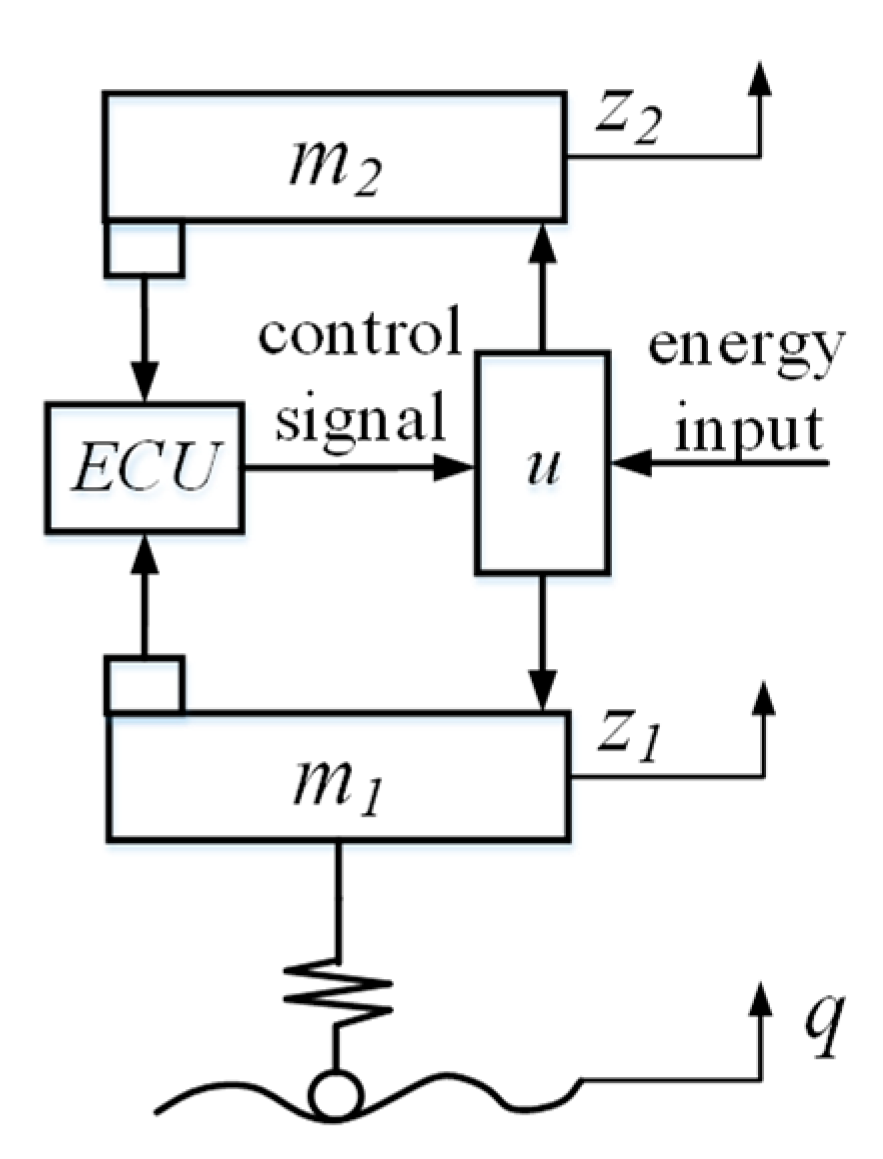
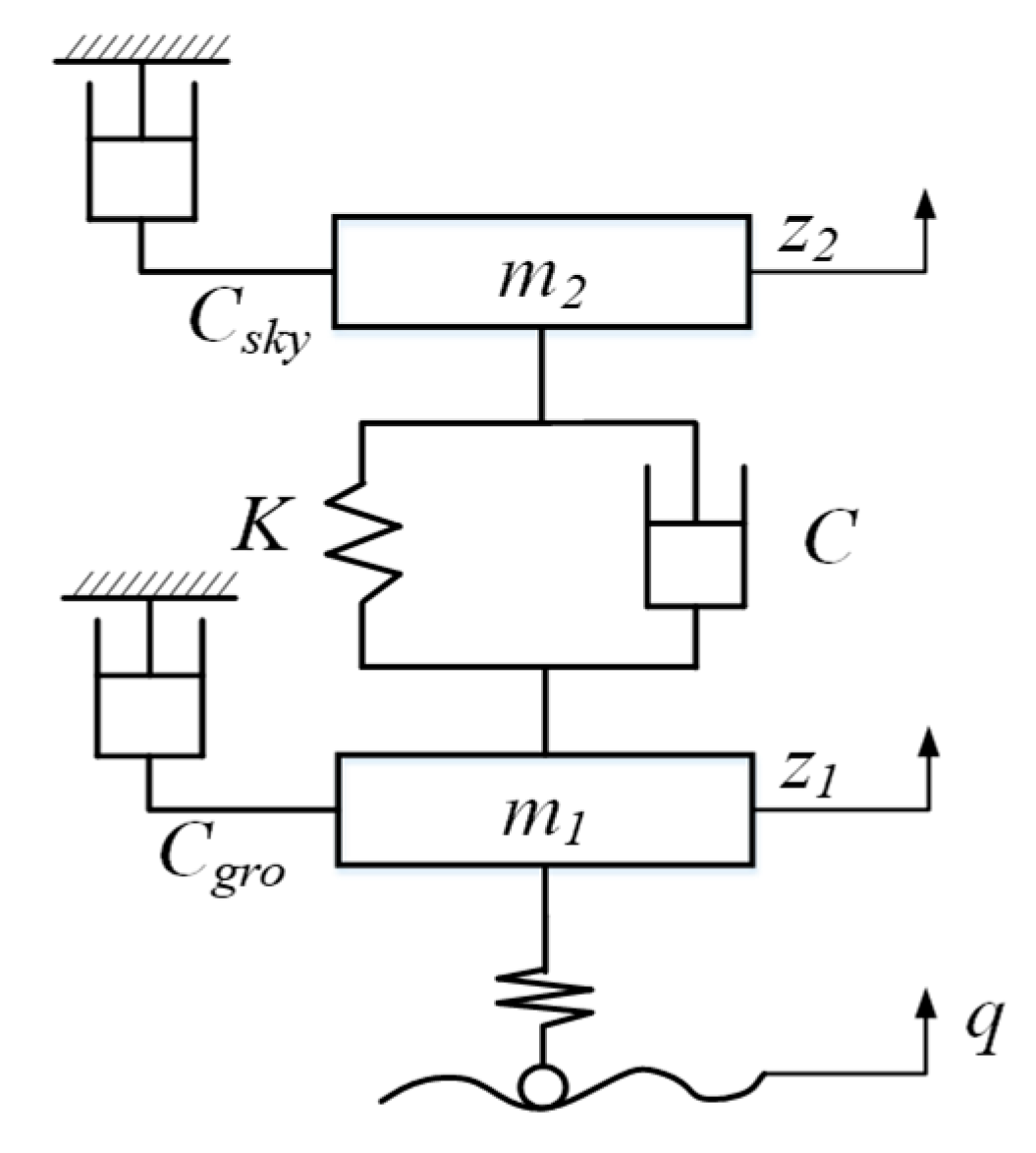
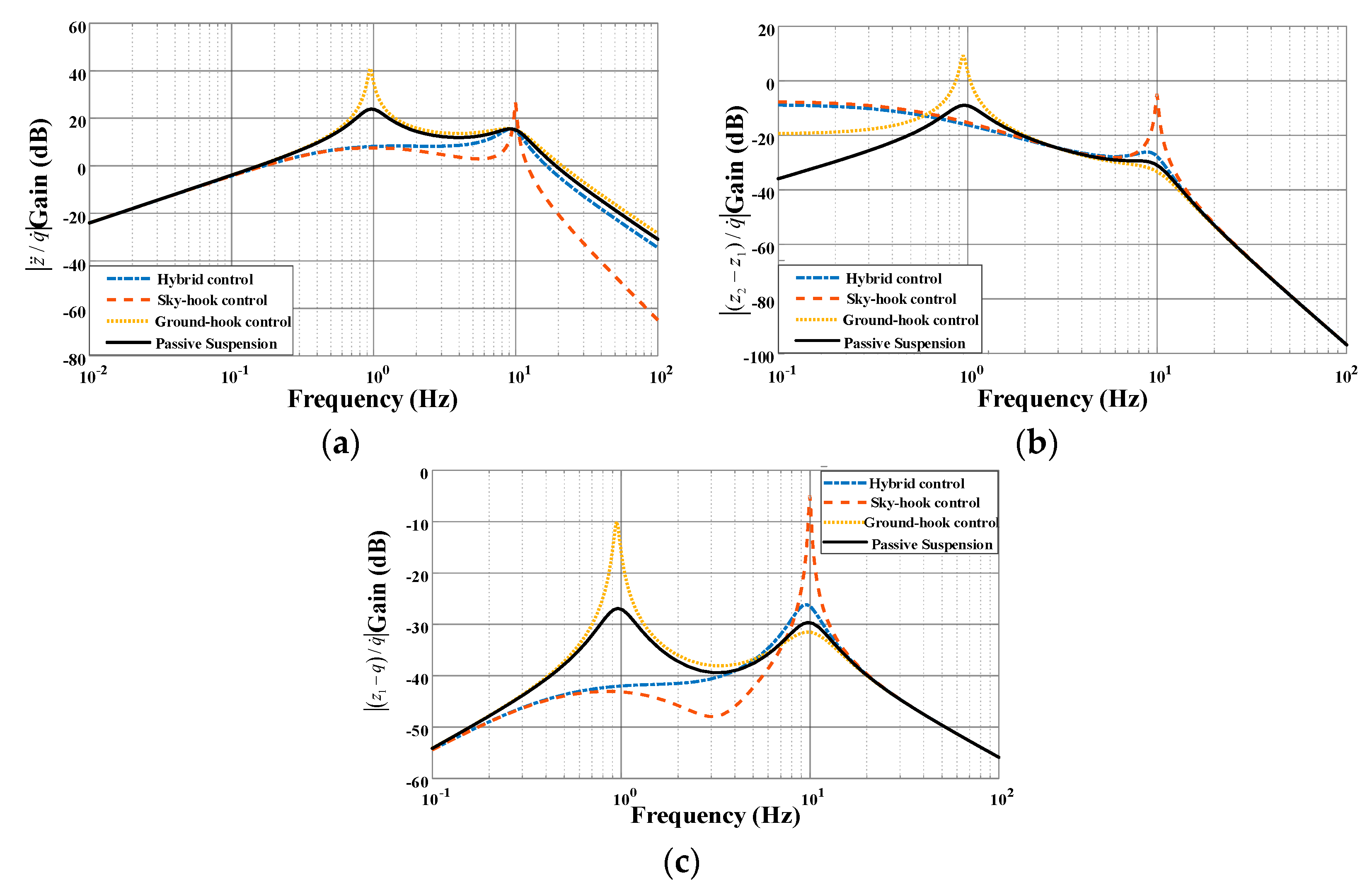

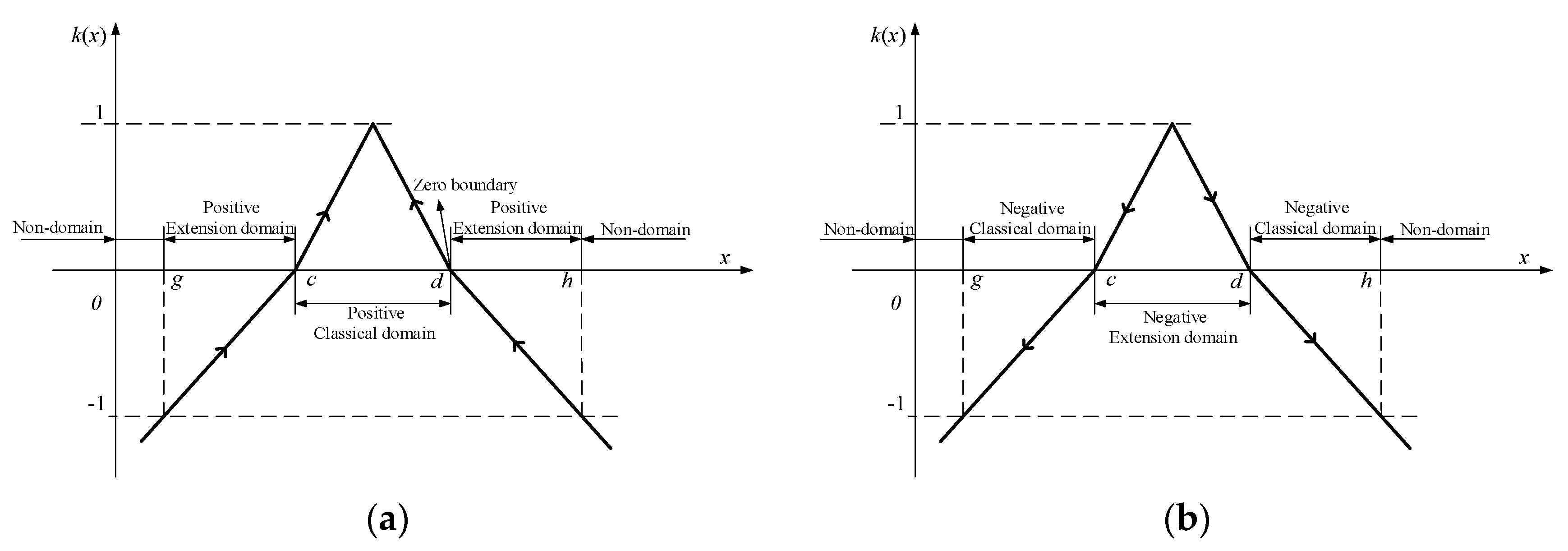
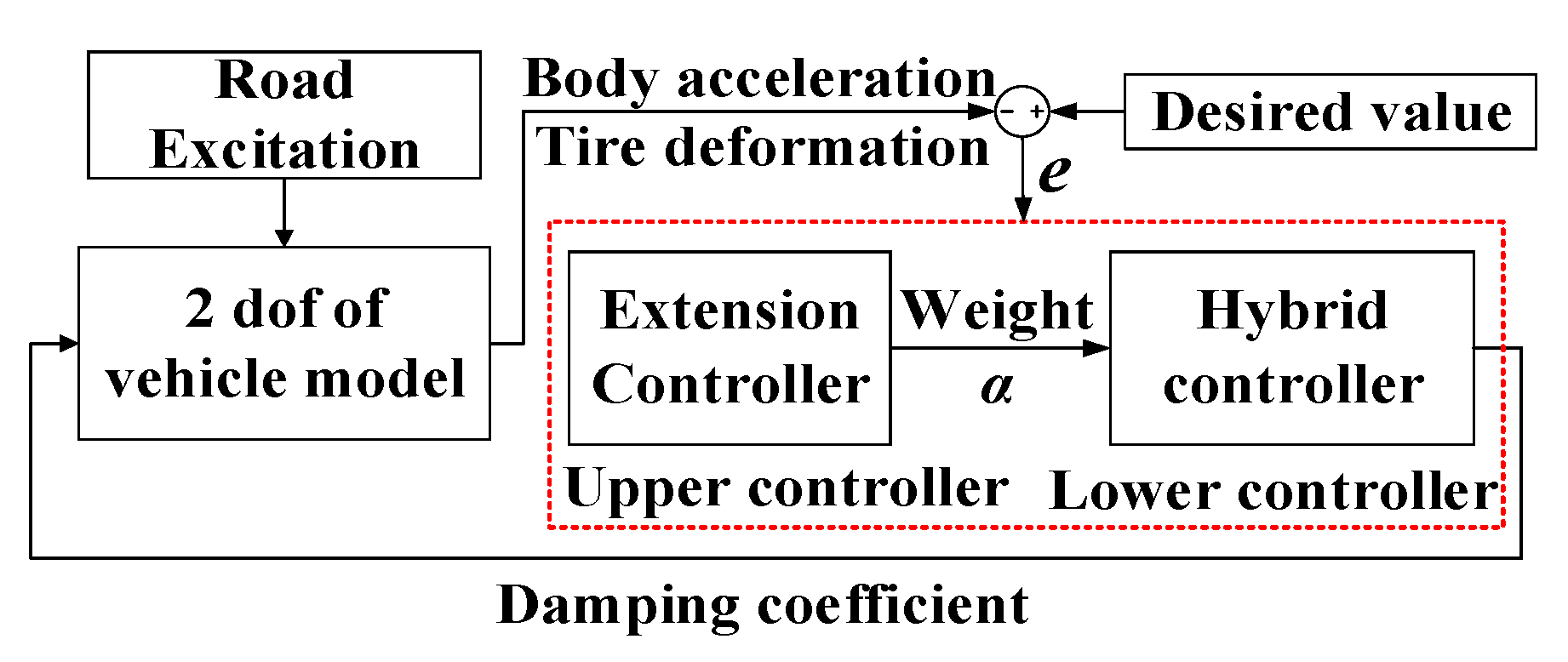

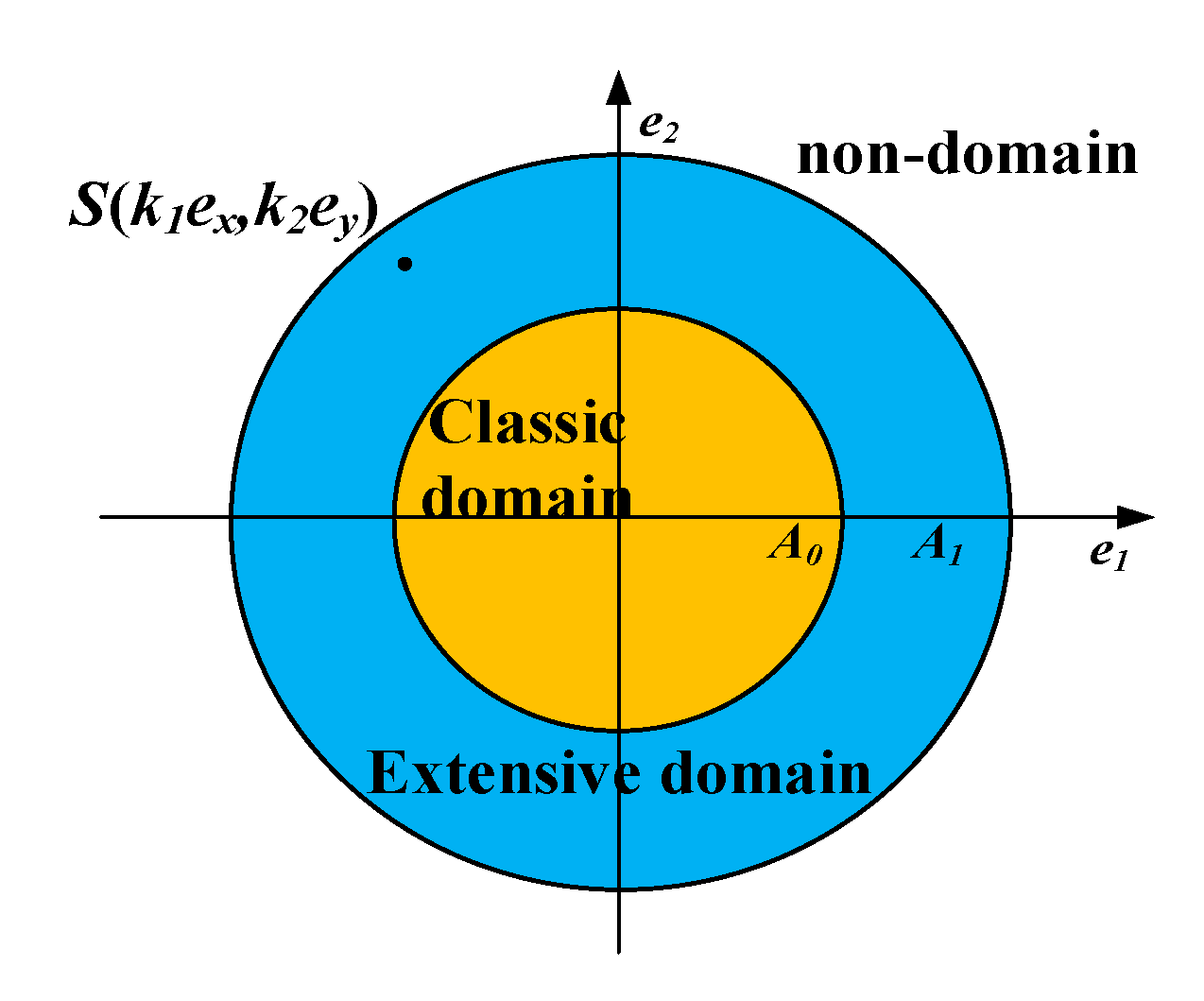

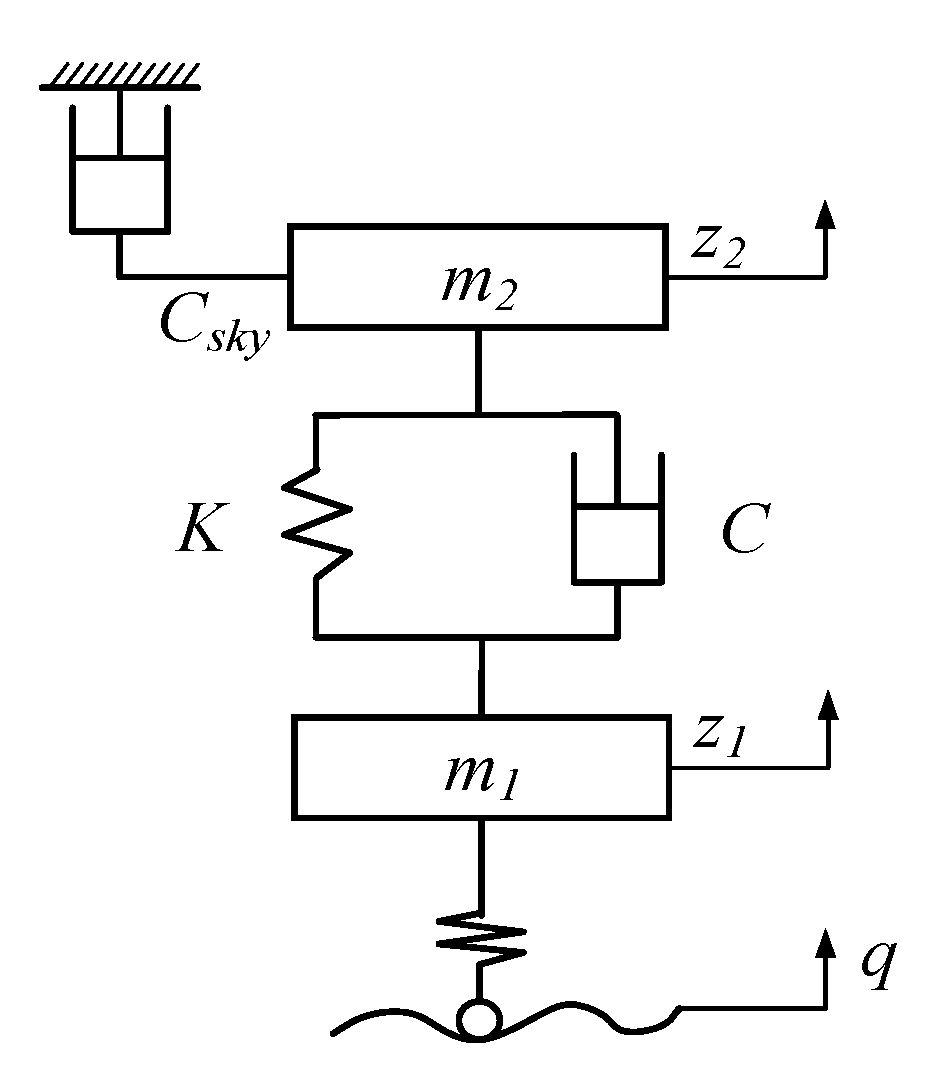
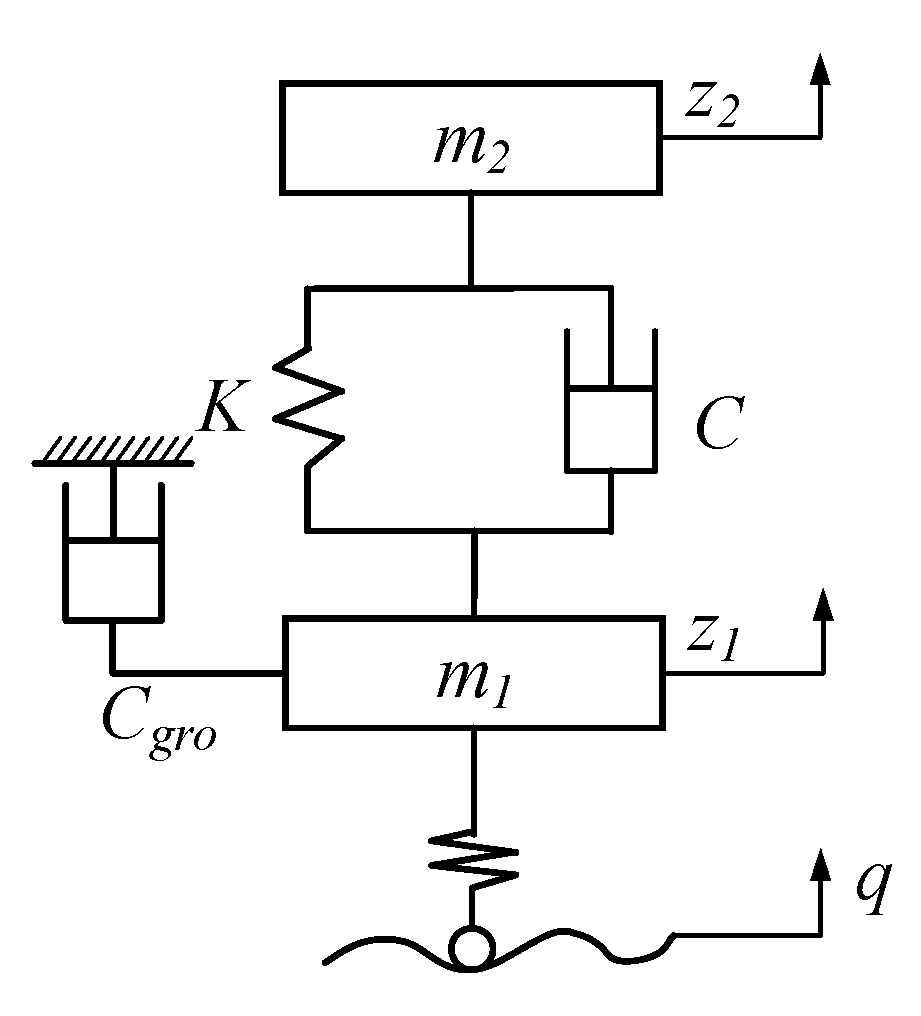
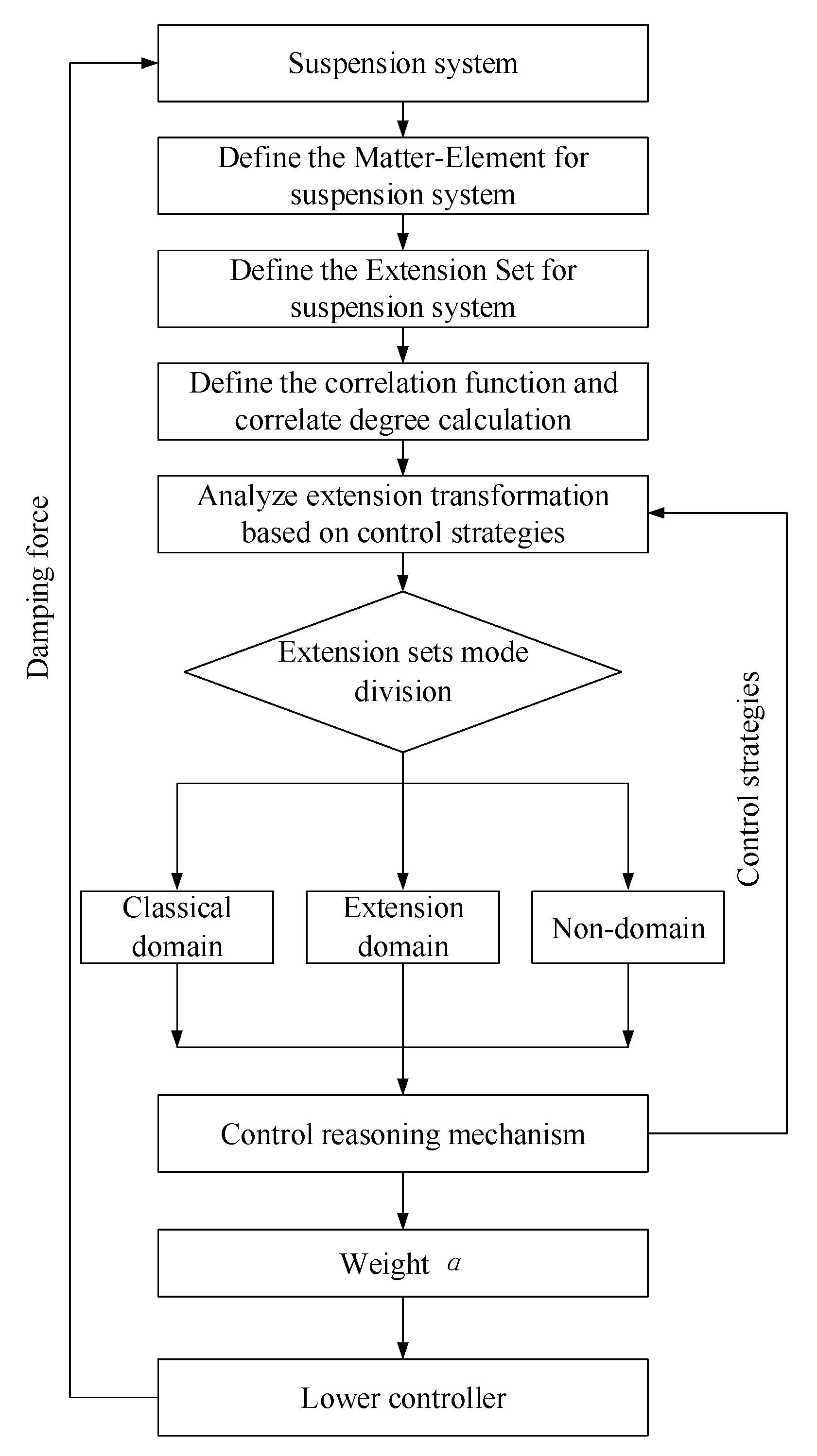
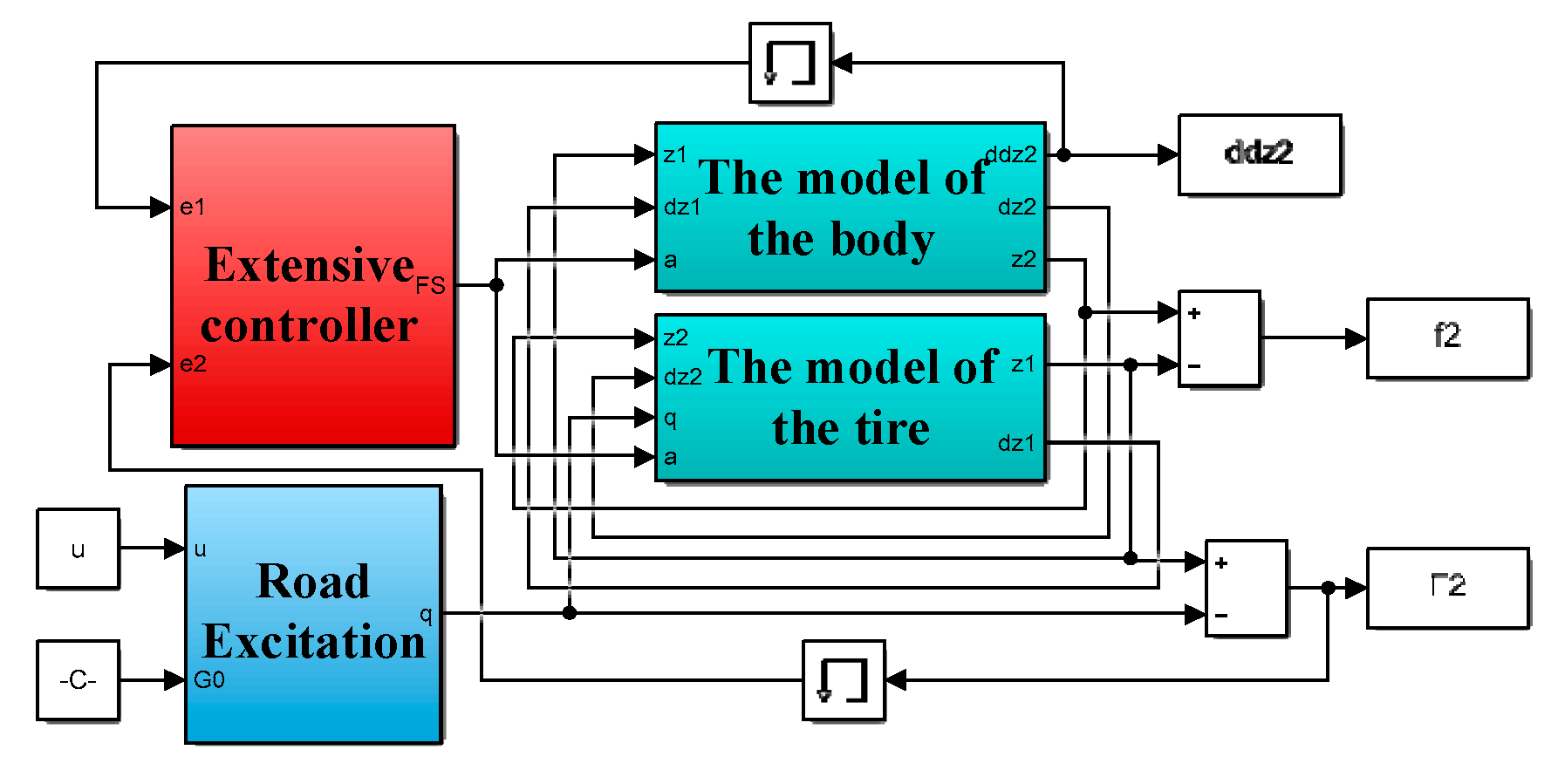
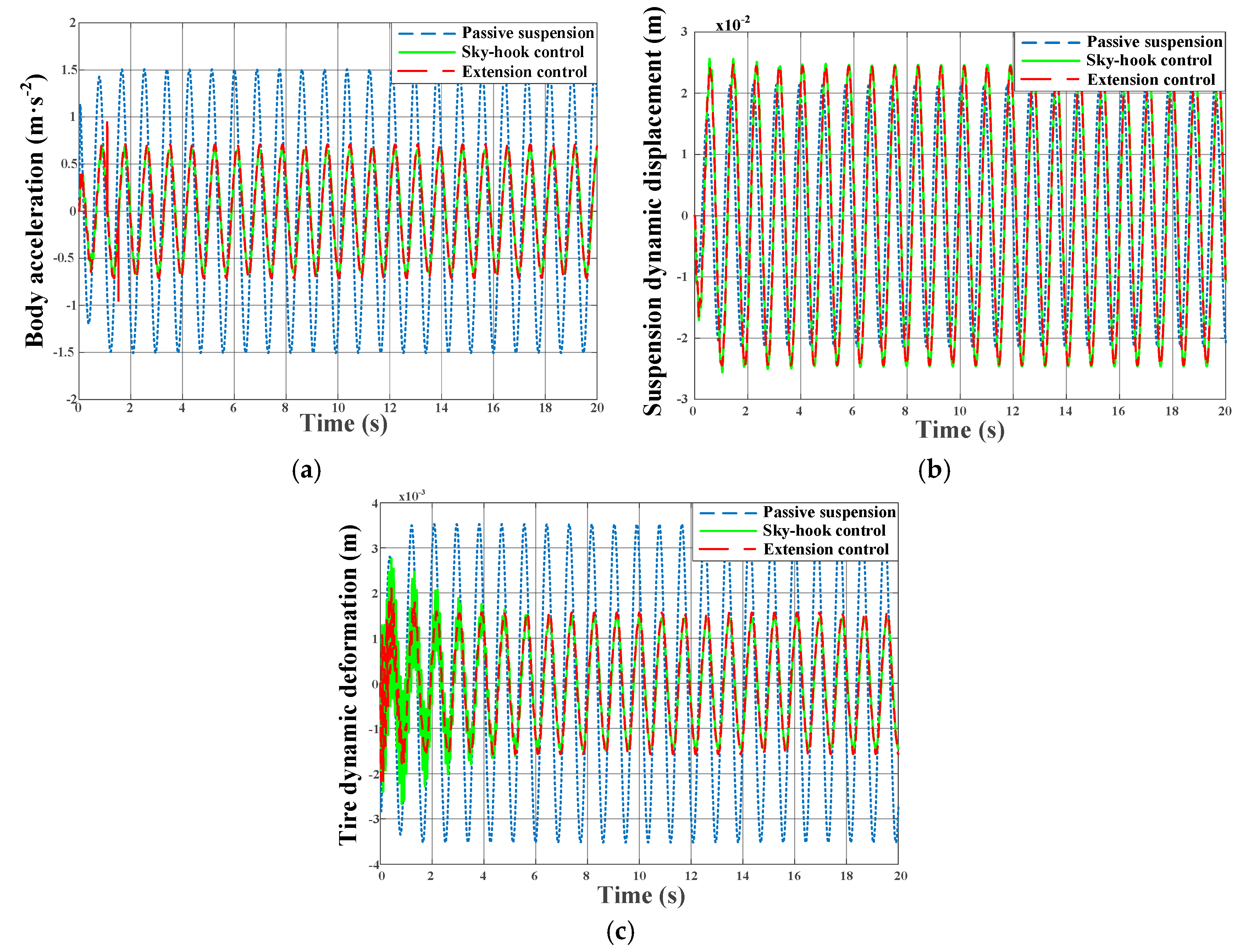
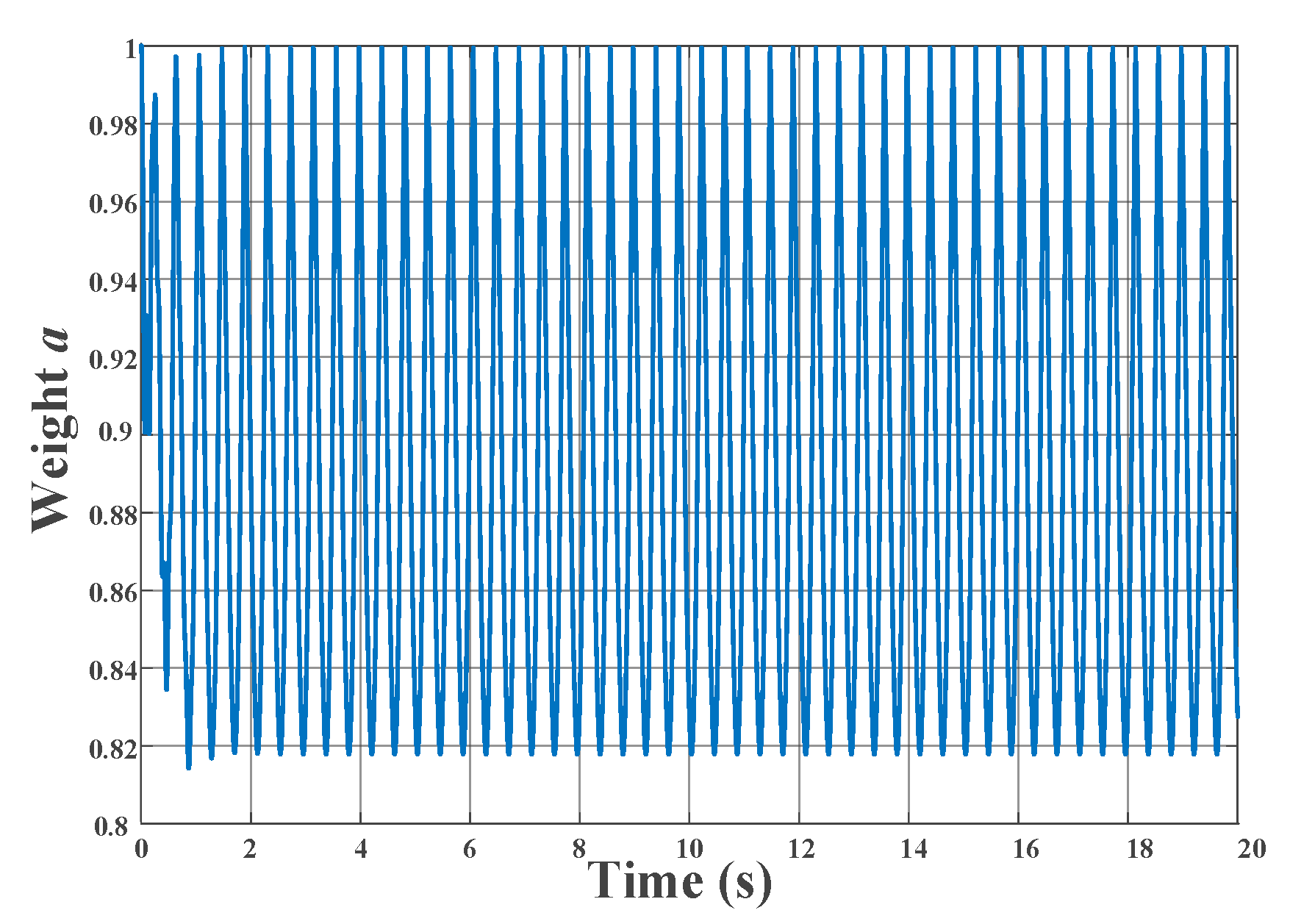
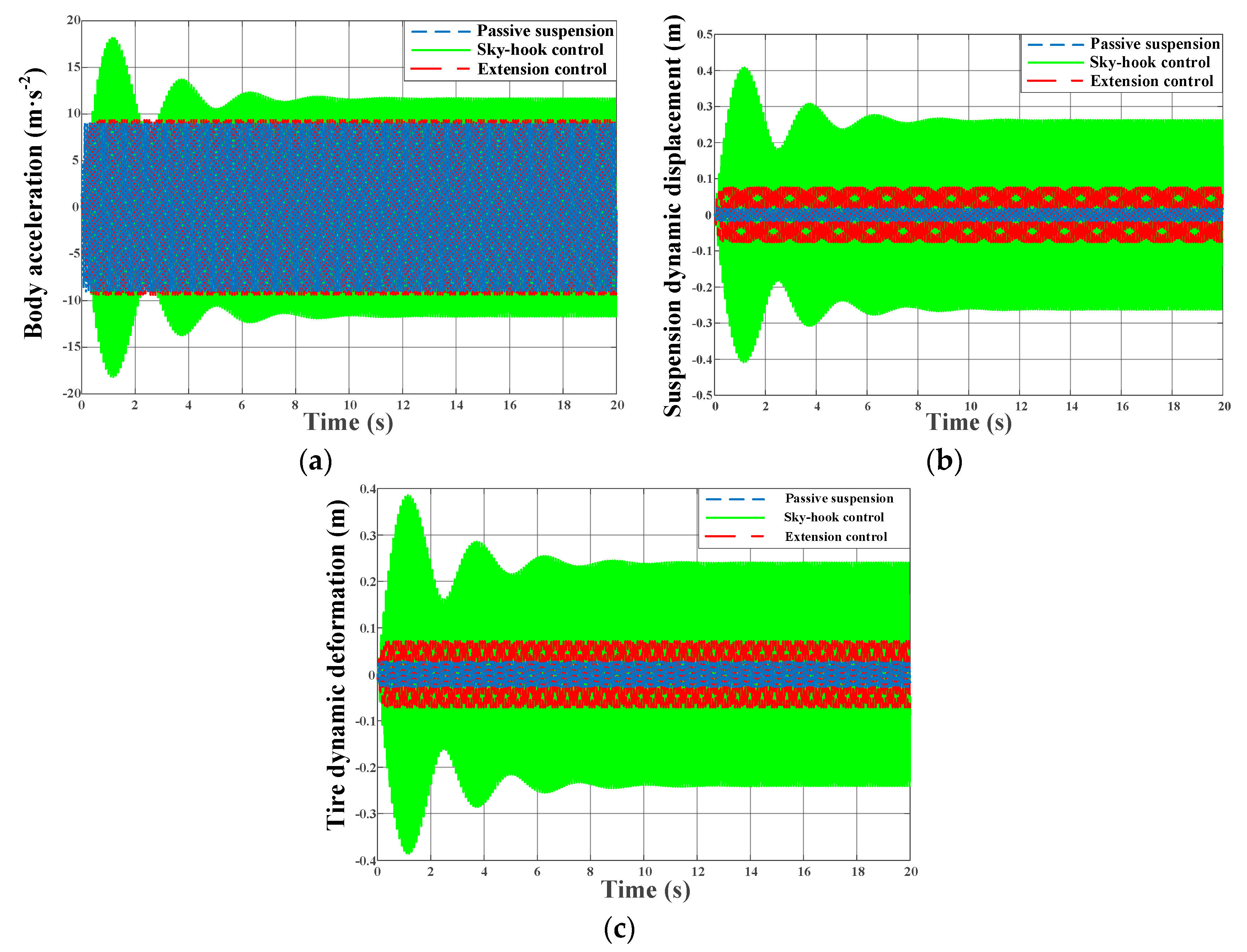
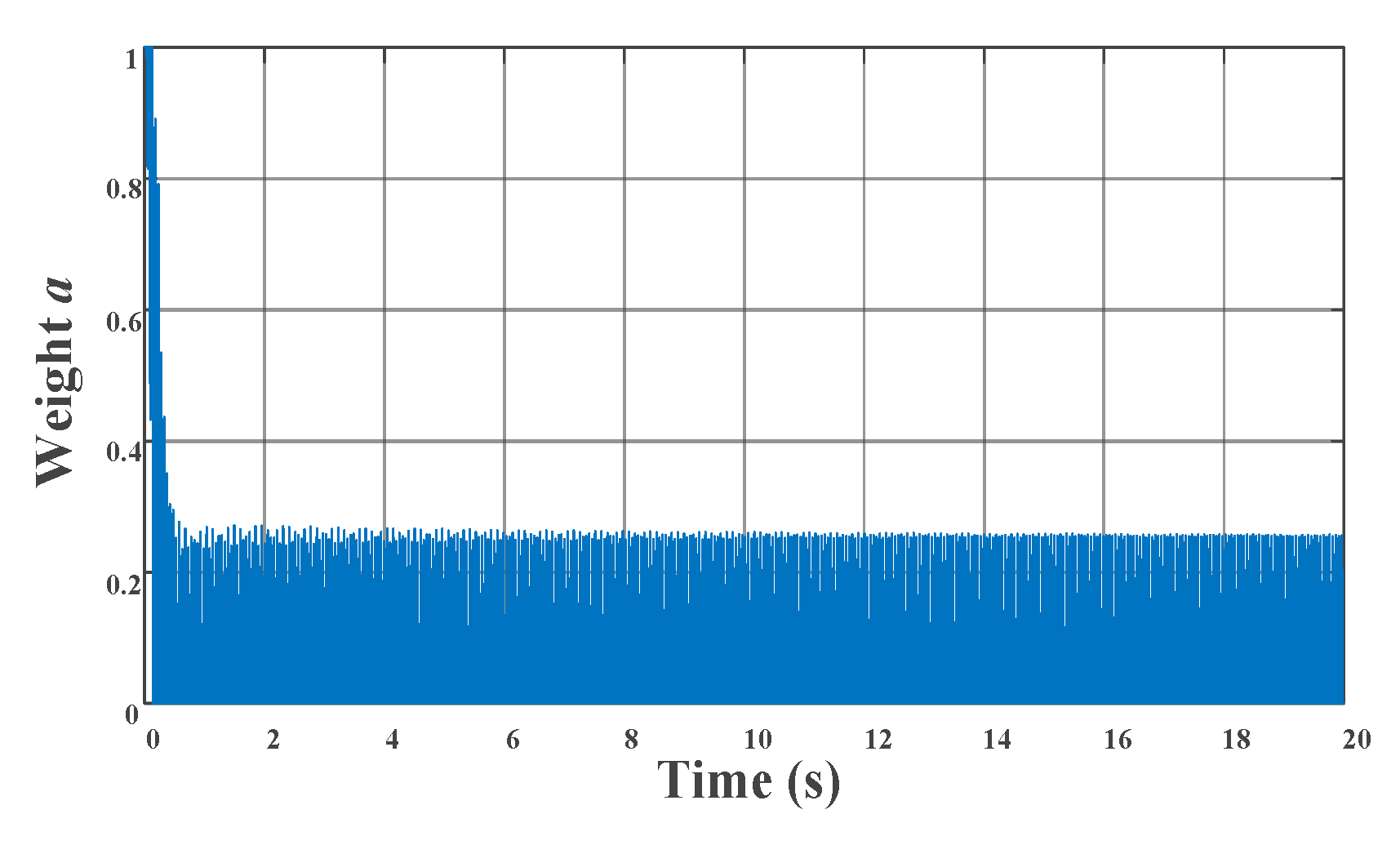
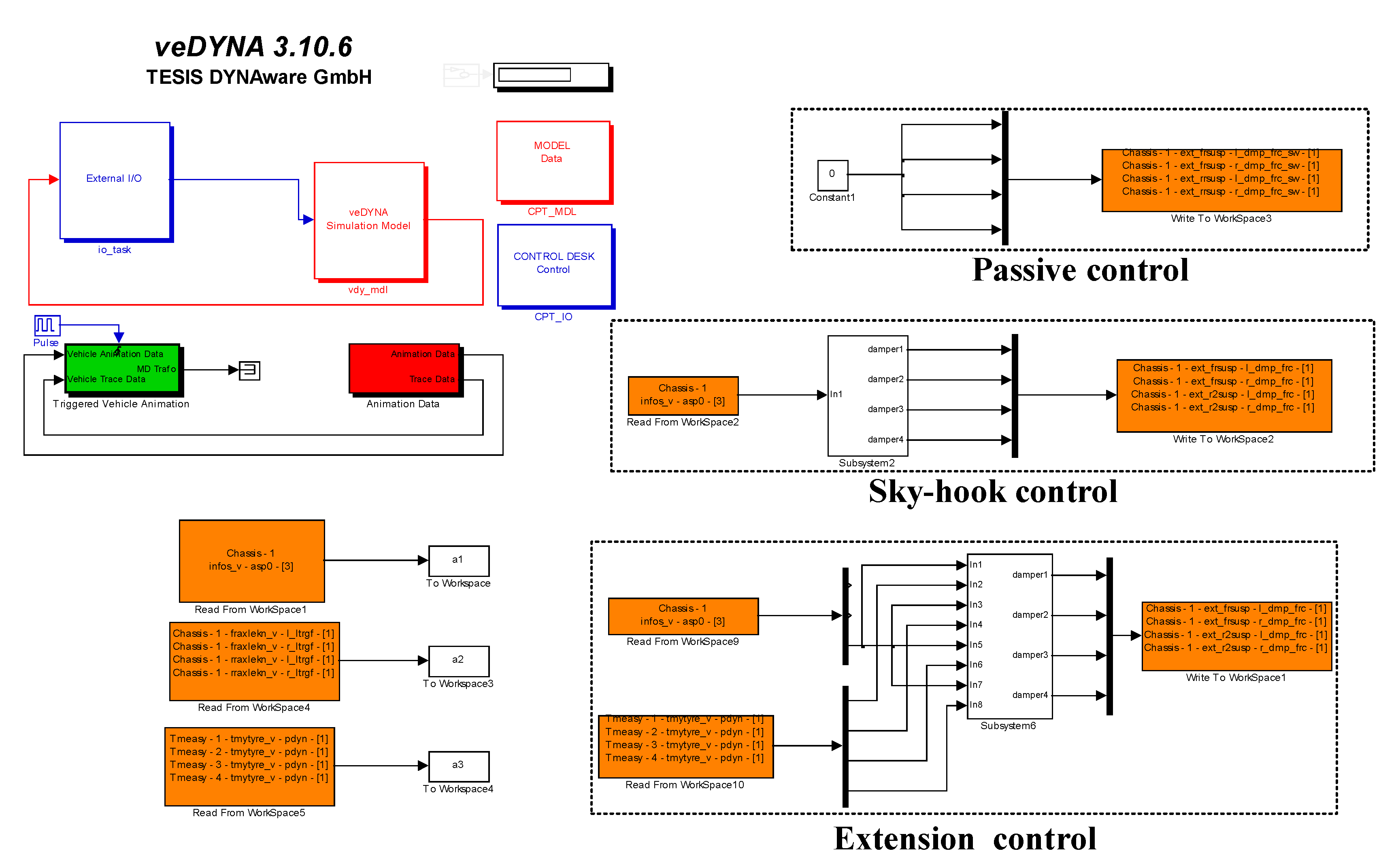
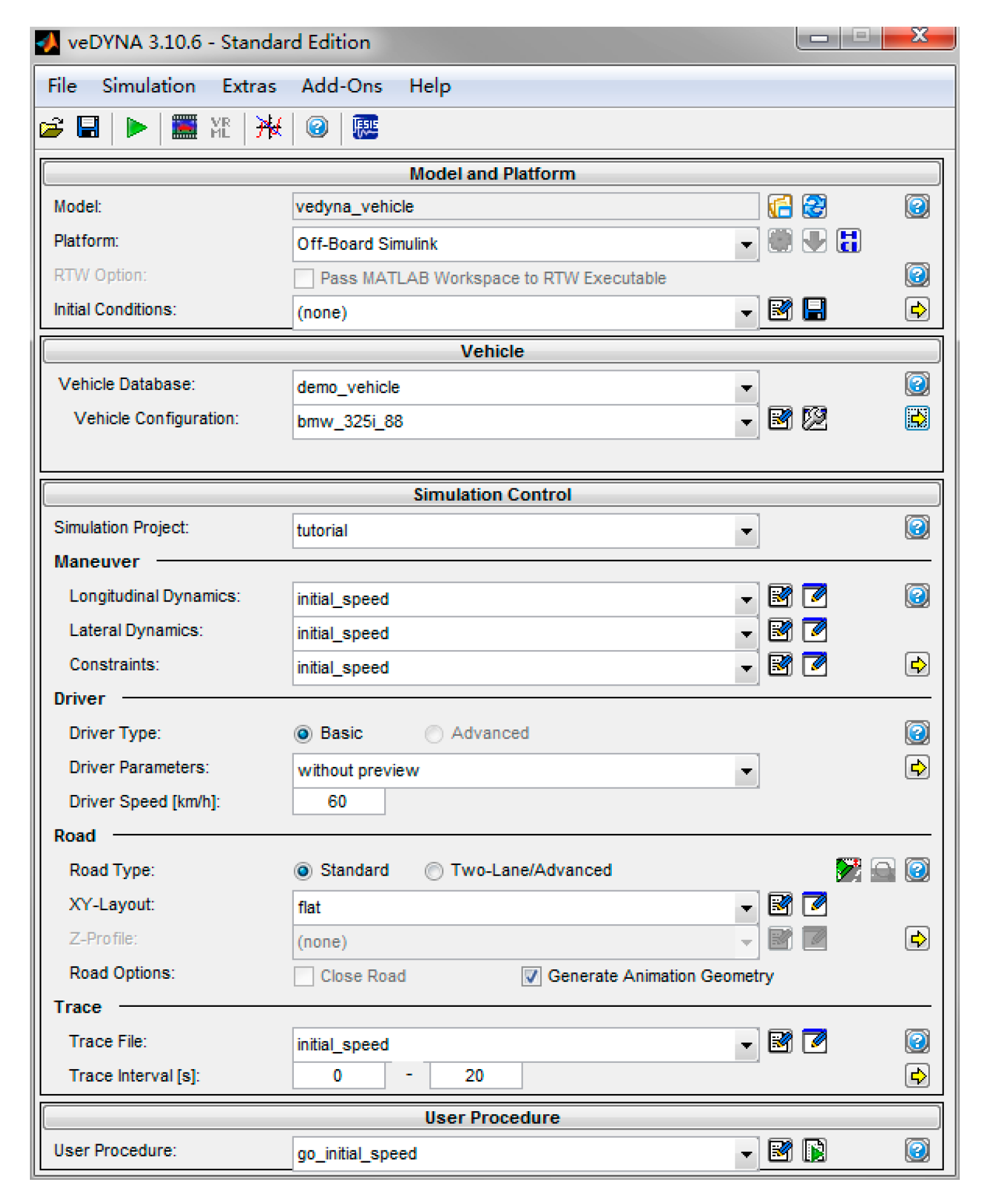

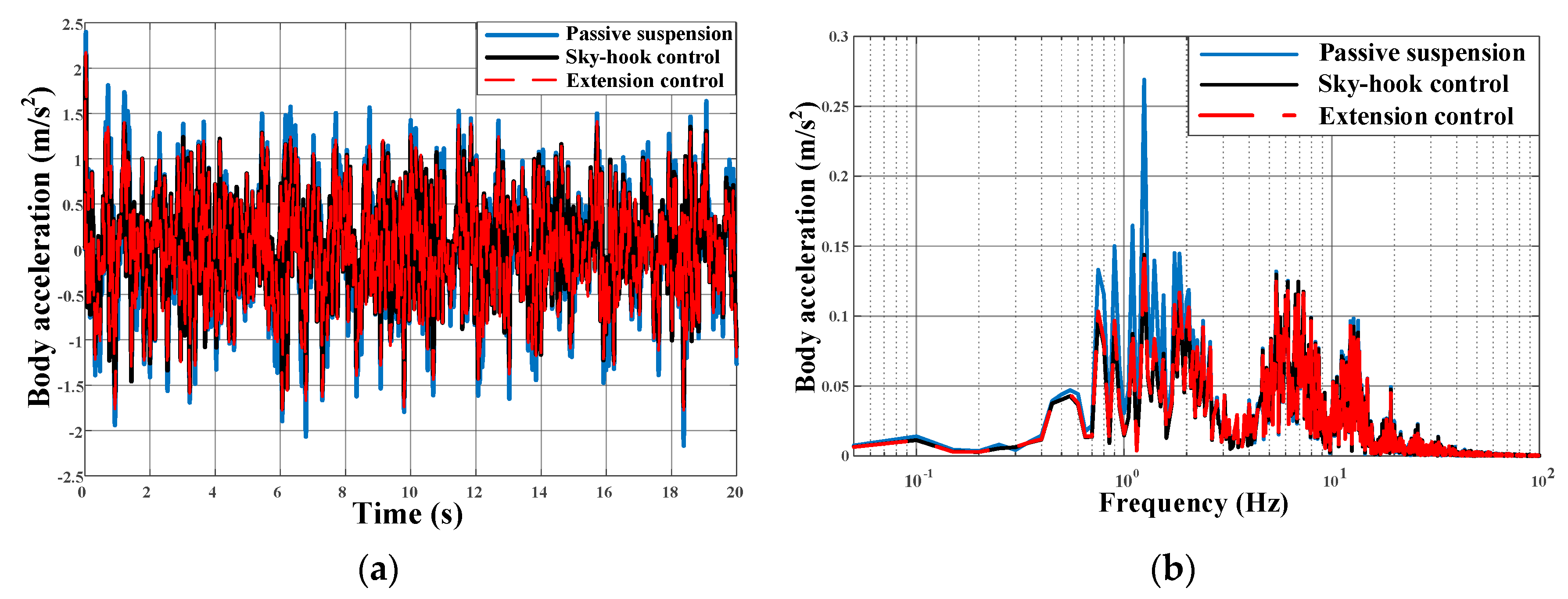
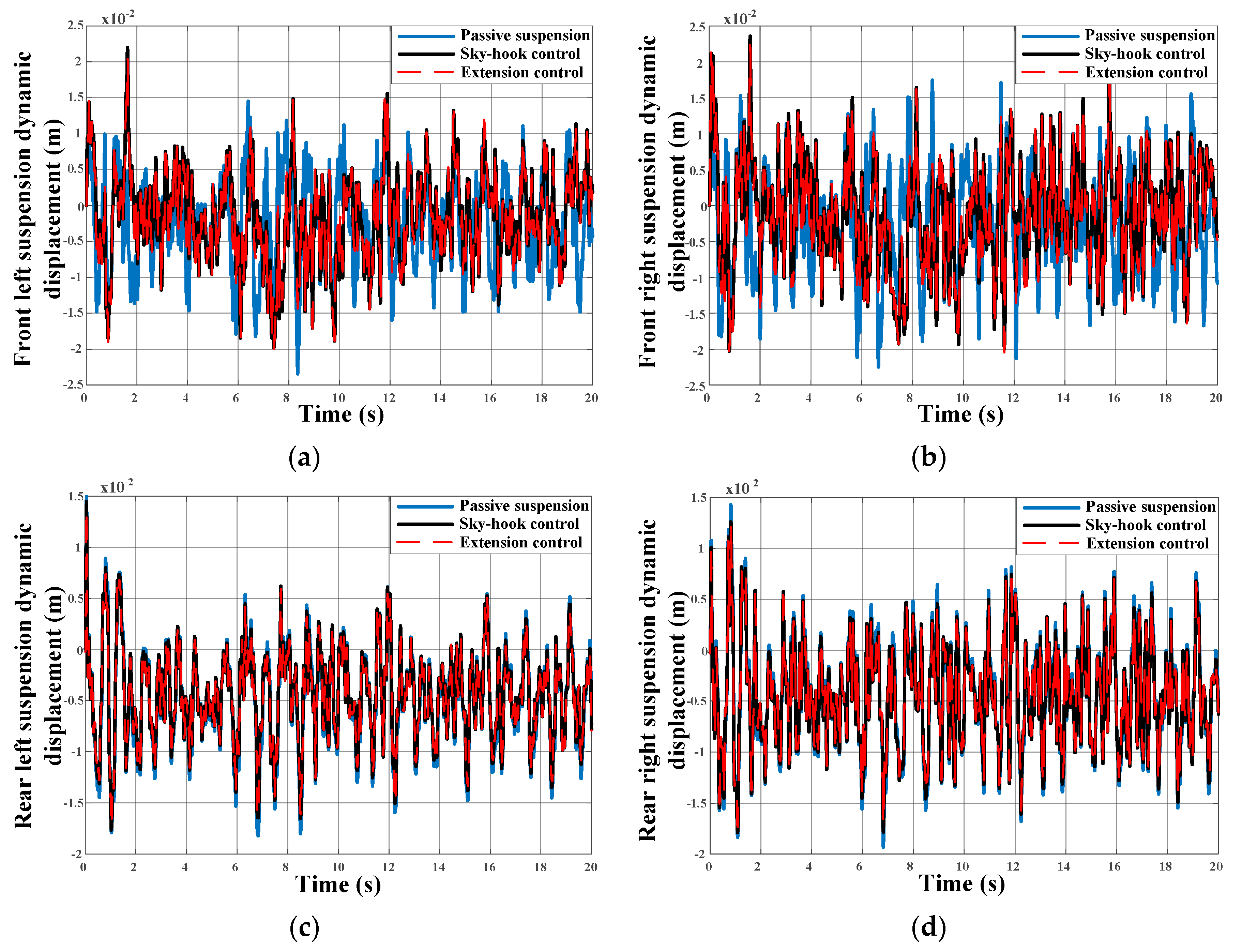
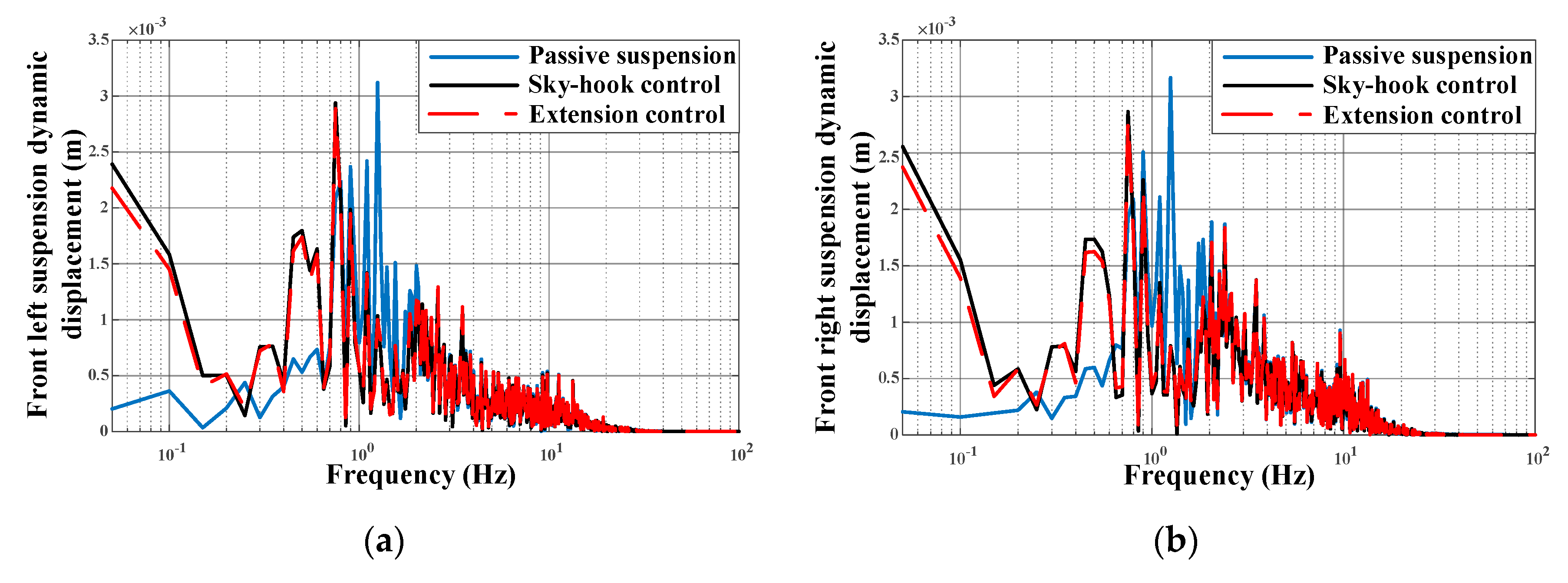
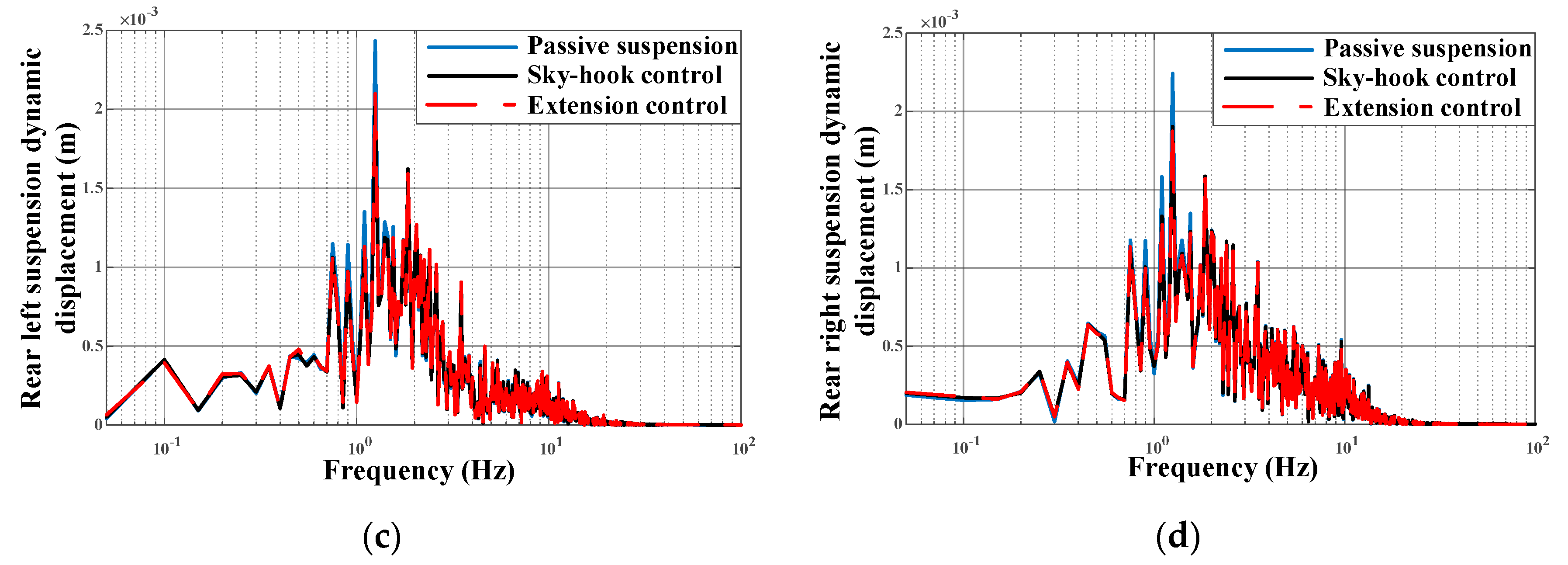

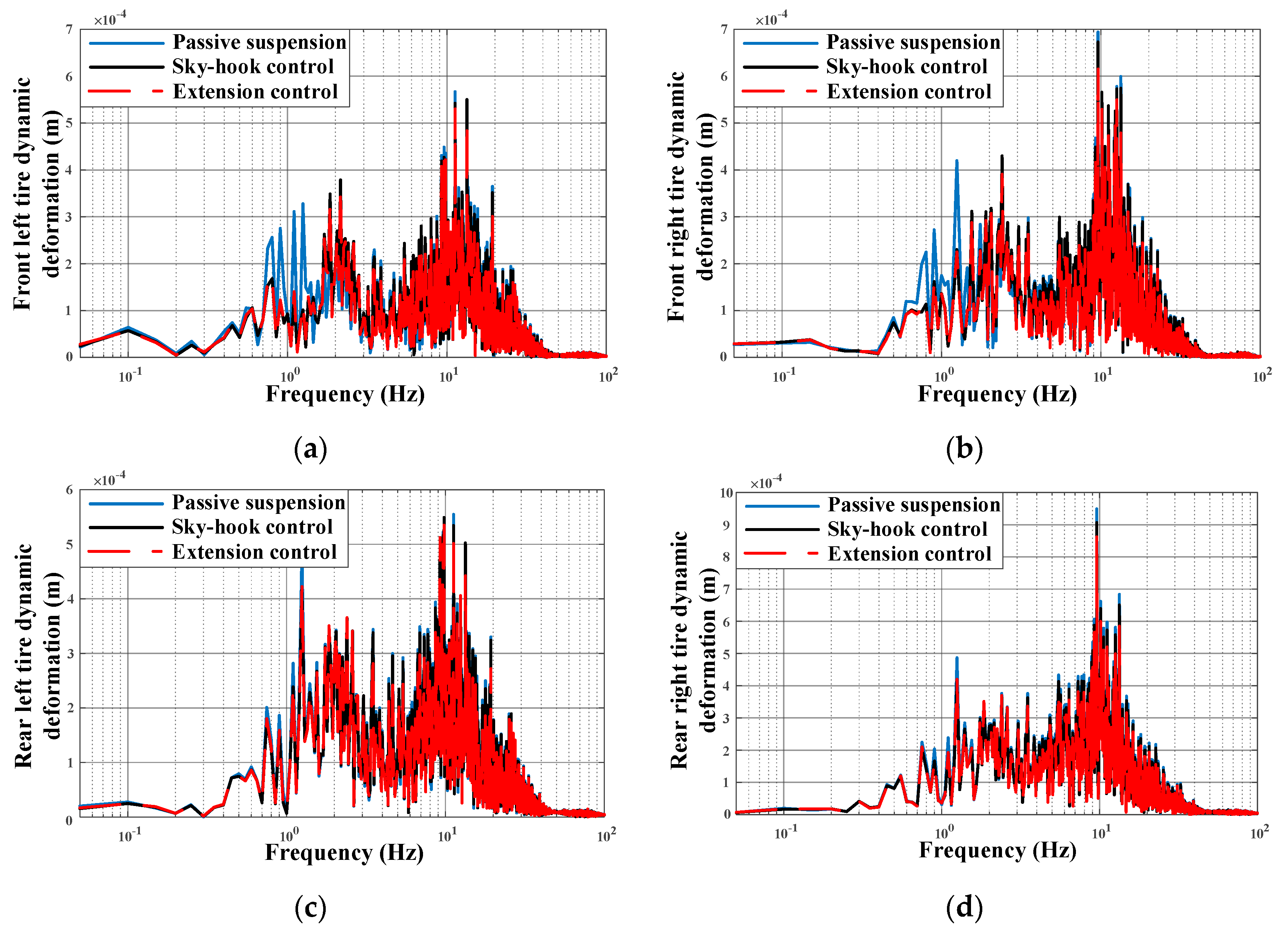
| Parameters | Value |
|---|---|
| Sprung mass M2 (kg) | 400 |
| Unsprung mass M1 (kg) | 40 |
| Tire stiffness Kt (N/m) | 180,000 |
| Suspension stiffness K (N/m) | 18,750 |
| Desired sky-hook damper Csky (N·s/m) | 4000 |
| Desired ground-hook damper Cgro (N·s/m) | 1500 |
| Parameters | Value |
|---|---|
| Maximum error of ride comfort under sky-hook control e10lim | 0.016 |
| Maximum error of safety under sky-hook control e20lim | 0.009 |
| Maximum error of ride comfort under sky-hook control e11lim | 1.1 |
| Maximum error of safety under sky-hook control e21lim | 2.5 |
| Factor k1 | 1 |
| Factor k2 | 600 |
| RMS | Passive Suspension | Sky-Hook Control | Extension Control |
|---|---|---|---|
| Body acceleration (m·s−2) | 1.1175 | 0.4698 | 0.4997 |
| Suspension dynamic displacement (m) | 0.0154 | 0.0174 | 0.0173 |
| Tire dynamic deformation (m) | 0.0026 | 0.0012 | 0.0011 |
| RMS | Passive Suspension | Sky-Hook Control | Extension Control |
|---|---|---|---|
| Body acceleration (m·s−2) | 6.3534 | 8.4417 | 6.5497 |
| Suspension dynamic displacement (m) | 0.0124 | 0.1896 | 0.0533 |
| Tire dynamic deformation (m) | 0.0192 | 0.1444 | 0.0501 |
| RMS | Passive Suspension | Sky-Hook Control | Extension Control |
|---|---|---|---|
| Body acceleration (m·s−2) | 0.6823 | 0.5945 | 0.5962 |
| Front left suspension dynamic displacement (m) | 0.0068 | 0.0064 | 0.0063 |
| Front right suspension dynamic displacement (m) | 0.0078 | 0.0072 | 0.0072 |
| Rear left suspension dynamic displacement (m) | 0.0067 | 0.0066 | 0.0066 |
| Rear right suspension dynamic displacement (m) | 0.0069 | 0. 0068 | 0.0068 |
| Front left tire dynamic deformation (m) | 0.01822 | 0.01803 | 0.01713 |
| Front right tire dynamic deformation (m) | 0.01840 | 0.01820 | 0.01749 |
| Rear left tire dynamic deformation (m) | 0.01773 | 0.01762 | 0.01702 |
| Rear right tire dynamic deformation (m) | 0.01777 | 0.01766 | 0.01702 |
© 2020 by the authors. Licensee MDPI, Basel, Switzerland. This article is an open access article distributed under the terms and conditions of the Creative Commons Attribution (CC BY) license (http://creativecommons.org/licenses/by/4.0/).
Share and Cite
Geng, G.; Yu, Y.; Sun, L.; Li, H. Research on Ride Comfort and Driving Safety under Hybrid Damping Extension Control for Suspension Systems. Appl. Sci. 2020, 10, 1442. https://doi.org/10.3390/app10041442
Geng G, Yu Y, Sun L, Li H. Research on Ride Comfort and Driving Safety under Hybrid Damping Extension Control for Suspension Systems. Applied Sciences. 2020; 10(4):1442. https://doi.org/10.3390/app10041442
Chicago/Turabian StyleGeng, Guoqing, Yi Yu, Liqin Sun, and Hao Li. 2020. "Research on Ride Comfort and Driving Safety under Hybrid Damping Extension Control for Suspension Systems" Applied Sciences 10, no. 4: 1442. https://doi.org/10.3390/app10041442





